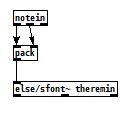-
 whale-av
posted in technical issues • read more
whale-av
posted in technical issues • read more@elmestrecalleu [pdcontrol] is part of Pd Vanilla... not an external but part of the Pd binary (since I think Pd 0.51)
You should be able to simply create (put) it into your patch.
David. -
 whale-av
posted in technical issues • read more
whale-av
posted in technical issues • read more@Yar You can try to find them for your system.
In the Pd top menu.... help..... find externals.... search..
tabletool and polygate~ exist updated for windows 64 bit but not polygate.
Help.. find externals... will only find externals for your OS.
Github might contain what you are looking for with the possibility to compile, but most externals have already been compiled for 64 bit systems now (by very helpful people).It might be an abstraction created by @ricky and he might show up here and help.
You can try a browser search..... "pdpatchrepo polygate" "pure data polygate" etc.
David. -
 whale-av
posted in technical issues • read more
whale-av
posted in technical issues • read more@Yar @ricky started and finished a discussion about this many years ago and used [vcf~] to extract the partials and [sigmund~] to analyse the signal...... https://forum.pdpatchrepo.info/topic/4196/extracting-partial-information
Might help...
David. -
 whale-av
posted in technical issues • read more
whale-av
posted in technical issues • read more@donnerbono https://forum.pdpatchrepo.info/topic/14477/toggling-visibility-of-sliders-buttons-in-pd
It is best to use the coords message, as the donecanvasdialog message does not work well since Pd 0.49.... as seen in the example it retains the first view the first time that the second view is selected.
It changes the area of a sub-patch displayed through a GOP window.You could also use abstractions for each window and make them visible by sending them [vis 1( messages.
example.zip
Open all three files and then click the messages in each as desired.......
You might want to add a message to turn off DSP processing in each hidden patch as you switch.Of course it could also be done with dynamic patching
David. -
 whale-av
posted in technical issues • read more
whale-av
posted in technical issues • read more@willblackhurst For the DAC the numbers have to be pushed out at the sample rate to create the analogue audio wave.... or it is just a meaningless data dump. And there is no "jamming".... it is just that the data then moves through the audio stream in Pd at that rate.
When a wav file is copied on the computer the data is of course moved as fast as the storage medium and the processor and the RAM I/O can manage..... which is also the case when you load audio to an [array].
[snapshot~] does what it should... outputs the audio stream value at the time that it is banged...... but because control rate operations are sent between blocks it reports the last value from the previous block.
So it does use the array list data if the array is being streamed (played) but only reports that one value at the point to which it is attached in your patch and at the time that it is banged.
And if you sample the stream from [tabplay~] after a [* 0.5] then the value will be halved.
If you want to see the whole previous block then use [print~] but that only reports the values to the console so it is not useful except for analysis when understanding how you want to use [vsomething~] objects.How Pd works... is in your Pd folder....... \doc\1.manual\resources\chapter2 ..... part 2.5.2 for tilde objects (audio processing)...
David. -
 whale-av
posted in technical issues • read more
whale-av
posted in technical issues • read more@Shabroy Only a wild guess...... that it might have something to do with the sample rate of the audio file?
Android native is 48kHz. It can resample but maybe PdParty has no instruction set for that?
David. -
 whale-av
posted in technical issues • read more
whale-av
posted in technical issues • read more@willblackhurst It's all numbers in a computer... digital.
As simply as possible.........
Tilde objects set processing of the digital audio thread in Pd. The digital audio is a stream of numbers representing the height of the equivalent analogue signal wave..
These numbers only become a voltage..... an analogue waveform when they are passed to the DAC... the digital to analogue converter.... your soundcard output.
The ADC is where the analogue signal is converted to numbers for input to the digital audio thread.
Audio files are stored on the computer disk as numbers.....
The numbers are read, streamed, processed and output at the sample rate.
The not simple answer can be found searching for FFT.
David. -
 whale-av
posted in technical issues • read more
whale-av
posted in technical issues • read more@Hello_Hello Welcome to the forum..
Please upload your patch. It is not normal.... so we need to see why it might be happening.
When you start a post you will see an UP arrow above where you are typing...... click that and browse to your patch to upload it.
David. -
 whale-av
posted in technical issues • read more
whale-av
posted in technical issues • read more@Shabroy Looks like you should be getting playback.
Are the arrays filled? ....... maybe you should put a [loadbang] to the read messages to fill the arrays at startup.
Is audio turned on?
You can do this if [loadbang] works in PdParty....... like_this.pd
David. -
 whale-av
posted in technical issues • read more
whale-av
posted in technical issues • read more@Shabroy I have modified conversion from decimal in the post above, adding the triggers.
You get the error message because when [tabplay~] gets to the end of the track it is sending a bang into the right inlet of [*~ 0.7]
So just remove that cord I think.....
David
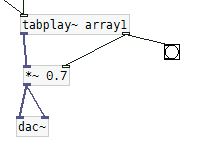
-
-
 whale-av
posted in technical issues • read more
whale-av
posted in technical issues • read more@jameslo Yes..... drunk and way past bedtime so rightly chastised.
Don't let me be misunderstood....
My intentions were good.
David -
 whale-av
posted in technical issues • read more
whale-av
posted in technical issues • read more@Shabroy https://www.calculatorsoup.com/calculators/conversions/convert-decimal-degrees-to-degrees-minutes-seconds.php
So........ (triggers included) gps_dec2deg_min_sec.pd
David.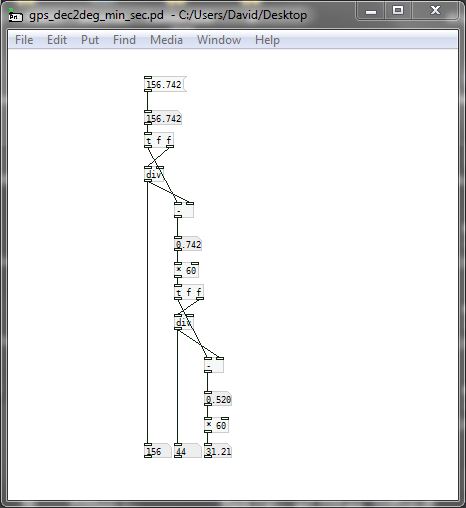
-
 whale-av
posted in technical issues • read more
whale-av
posted in technical issues • read more@Shabroy Not sure, but in the [expr] object $f1 is the left inlet... lat
and $f2 is the right inlet....... lonSo reading the values from left to right in [expr] in my example "maybe.pd"
1.12 is the minimum GPS value for latitude to trigger playback
5.12 is the maximum GPS value for latitude to trigger playback
7 is the minimum GPS value for longitude to trigger playback
14.8 is the maximum GPS value for longitude to trigger playbackHave a look at where you are and the values that [r #loc] is sending.
Both latitude and longitude have to be in range for playback to be triggered and you need to change the values to encompass (good pun) the place where you will be when it should trigger.
Hoping that helps as I have no way to test your patch even if you upload it.
Maybe someone else could help with that if you cannot get it working.Also maybe you need a path set to your sound file on the iPhone.
That is mentioned somewhere in the Doc for PdParty.
David. -
 whale-av
posted in technical issues • read more
whale-av
posted in technical issues • read more@Shabroy In PdParty_composerpack\PdParty_composerpack\lib\pd you have playback.pd which needs to be triggered for playback when your parameters from loc are in range...... and only once or playback will be triggered repeatedly by incoming data and restart the file.
So you need to send to [r #transport] the message
[playback filename.extension(
|
[s #transport]You need to control that with a patch something like..... maybe.pd
[expr if ()] is the geofence for lat and lon... outputs 1 for inside, 0 for outside.... (logical true/false)....
David.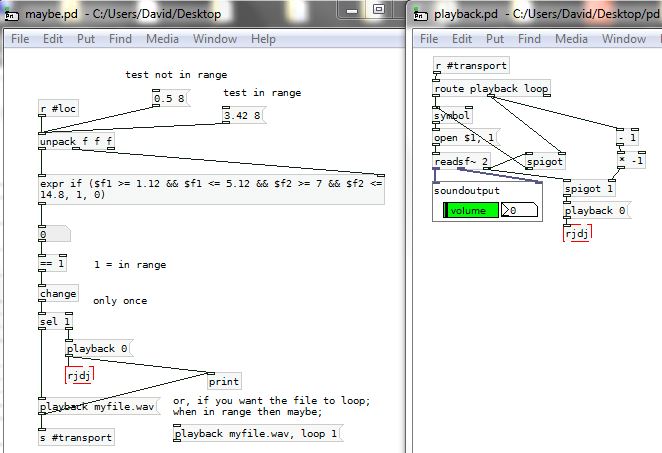
-
 whale-av
posted in technical issues • read more
whale-av
posted in technical issues • read more@Shabroy I was mistaken about the "underline".
It is used in patch names to differentiate them from sends and receives.
[r_#name] for the patch but [r #name for a receive.
You found that patch as [main] in PdParty_composerpack\PdParty_composerpack\tests\pdparty\Loc in.......> http://danomatika.com/code/pdparty/PdParty_composerpack.zipIt is probably the "Detailed Instructions" in https://danomatika.com/code/pdparty/guide that need to be followed...
As I understand it when the patches are uploaded to ios the patches and GUI's cannot be directly connected by cords.... all connections have to be made using sends and receives.
David. -
 whale-av
posted in technical issues • read more
whale-av
posted in technical issues • read more@Shabroy I don't have an ios device so I am flailing around in the dark.
But you should try [r_#loc-help] which has a spigot to open for data to flow (It seems that the format is definitely [r_#x] with no spaces).
And although these rj patches are useful for debugging it seems that the [rj_loc] object is required and is only created on an I-device.... presumably the same as the ios window screenshot (Loc ... see below) from the PdParty/Guide PDF.
I might read this..... https://danomatika.com/code/pdparty/guide ... when I get time.
It seems to explain such things...
And I imagine that this.....
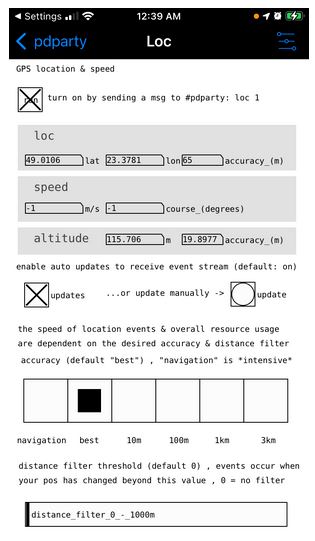
... exists somewhere in the PdParty download......... https://danomatika.com/code/pdparty
David. -
 whale-av
posted in technical issues • read more
whale-av
posted in technical issues • read more@impression You are running this on an RPI so have a look at this thread... https://scsynth.org/t/limit-to-maximum-number-of-osc-messages-that-can-be-received-in-short-time/8641/6
The sysctl command will probably help.
David. -
 whale-av
posted in technical issues • read more
whale-av
posted in technical issues • read more@c_c I think you will always have artefacts as the delay read point changes.
Even if you have 2 delays and swap (flip-flop) between them you will hear the change.
But if you crossfade between the 2 delays maybe your ears/brain will be deceived.
You will need to find a sweet spot for the length of the crossfade dependant on the range of the timing changes.
David. -
 whale-av
posted in technical issues • read more
whale-av
posted in technical issues • read more@Shabroy It seems that you have to enable GPS in PdParty........
Chapter 3.2.5 here........ https://danomatika.com/publications/pdparty_pdcon_16.pdf
.... and then receive the data through an [r #loc] object...... then [unpack f f f] for lon, lat, accuracy.You will find a lot of help on Github..... especially here...... https://github.com/rjdj/rjlib/blob/master/rj/r_%23loc-help.pd
It is old but should still be good.... and there are patches for generation too.
You should grab the whole rjlib here..... https://github.com/rjdj
David.

